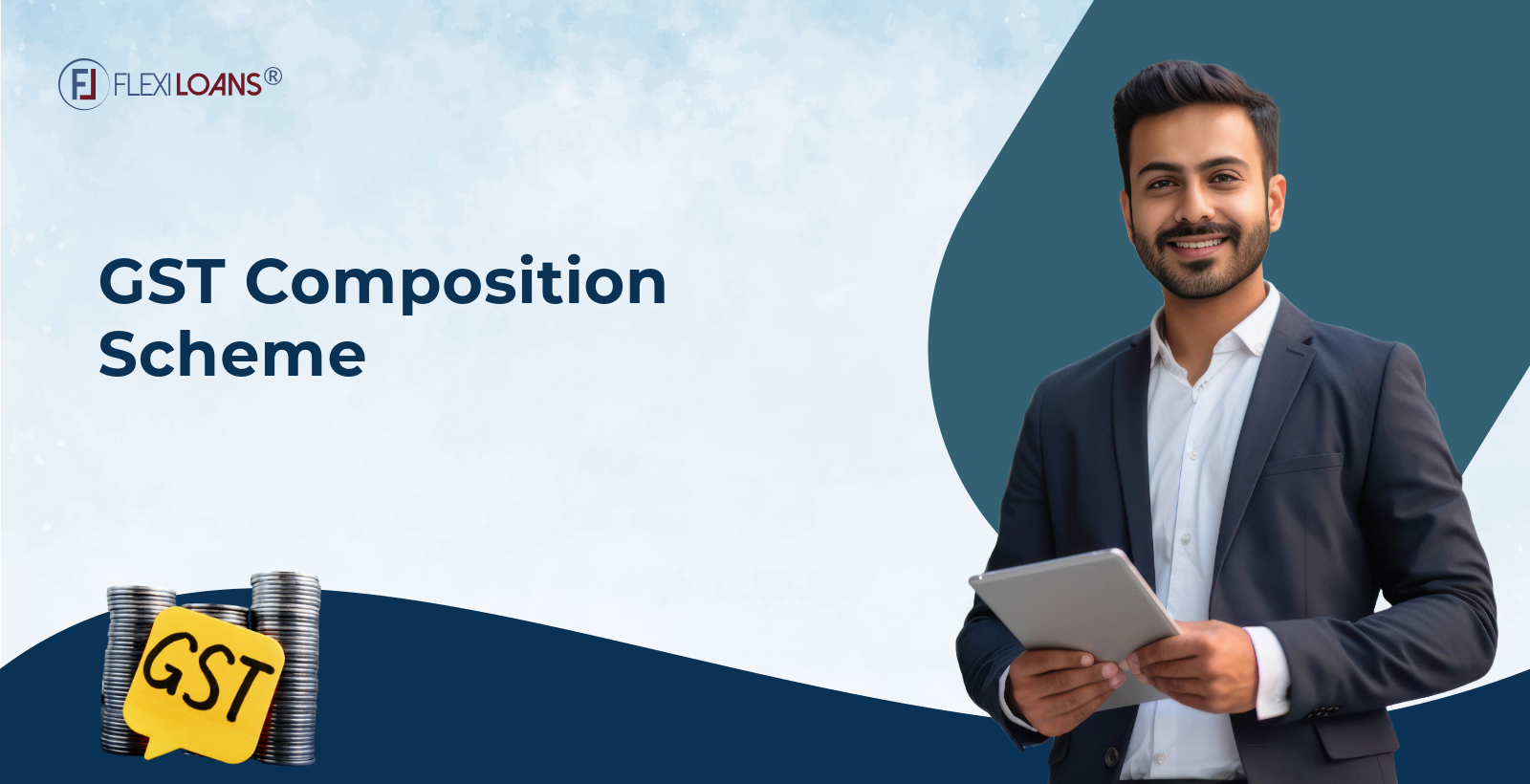Apr 22, 2025
Apr 23, 2025

What is GST Composition Scheme? It’s a simplified tax option designed for small businesses with limited turnover. This scheme allows eligible taxpayers to pay GST at a fixed rate while avoiding complex filings and detailed recordkeeping. However, it does not permit input tax credit (ITC), but offers ease and efficiency.
The government introduced the GST Composition Scheme to make GST for MSMEs more manageable. It reduces the burden of frequent return filings and complex tax calculations.
Therefore, if you are a trader, manufacturer, or restaurant owner seeking GST tax benefits for small businesses, this guide will help you make informed choices.
Read More: Top 6 GOVERNMENT BUSINESS LOAN SCHEMES 2024
Eligibility Criteria for GST Composition Scheme
The GST Composition Scheme simplifies GST registration for small businesses. However, not every business qualifies. Let’s understand who is eligible for GST Composition Scheme and who isn’t.
Who Can Opt for the GST Composition Scheme?
Businesses that meet the following conditions can choose the scheme:
- Manufacturers, traders, and restaurants not serving alcohol.
- Service providers (with certain limitations).
- Businesses operating within the same state.
- Those who agree not to claim input tax credit (ITC).
- Sellers making intra-state supplies (within the same state).
This makes it ideal for small businesses, especially those with straightforward operations.
Read More: 10 Smart Ways to Use MSME/SME Loans to Expand Your Business
Who Cannot Opt for the Scheme?
The following are not eligible:
- Businesses making interstate supplies.
- Suppliers through e-commerce platforms.
- Non-resident taxable persons and casual taxable persons.
- Businesses dealing in goods that are not taxable under GST (e.g., petroleum products).
- Businesses engaged in ice cream, tobacco, or pan masala manufacturing.
Turnover Limits for GST Composition Scheme
One of the key factors is the GST turnover limit:
- For manufacturers and traders: up to ₹1.5 crore annually (₹75 lakh in select states).
- For service providers: up to ₹50 lakh per year.
So, if your turnover stays within this limit and you meet the other conditions, you can benefit from simplified compliance under the scheme.
Read More: What is NSIC: Full-Form, Registration, Certificate, and Types
GST Composition Scheme Tax Rates
Here’s a look at the current GST Composition tax rates across various eligible business categories:
| Business Type | GST Rate |
|---|---|
| Manufacturers and traders | 1% (0.5% CGST + 0.5% SGST) |
| Restaurants (not serving alcohol) | 5% (2.5% CGST + 2.5% SGST) |
| Service providers (limited category) | 6% (3% CGST + 3% SGST) |
These flat rates simplify GST for manufacturers and traders, as well as GST on restaurant businesses, allowing them to calculate taxes easily without detailed invoicing or ITC adjustments.
Understanding the Tax Calculation
Under the GST Composition Scheme, tax is calculated on total turnover in the state.
For example, if a trader’s turnover is ₹60 lakh, the GST payable would be 1% of ₹60 lakhs, which is equal to ₹60,000.
Businesses are not allowed to collect GST from customers under this scheme and must pay it from their own pocket.
Benefits of GST Composition Scheme for Small Businesses
The advantages of GST Composition Scheme make it a practical choice for small businesses trying to stay GST compliant without spending too much time or money. Here’s how it helps:
- Lower Compliance Burden: One of the biggest GST benefits for MSMEs is that it reduces paperwork. Businesses under the scheme need to file returns quarterly instead of monthly, saving time and effort.
- Reduced Tax Liability: Instead of standard GST rates (which range from 5% to 28%), you pay a lower, fixed rate based on your turnover. This gives significant small business tax benefits.
- No Need for Detailed Tax Invoices: You can issue a simple bill of supply instead of detailed tax invoices. This makes billing easier and faster, especially for small traders.
- Cash Flow Benefits: Paying lower taxes frees up working capital. This helps small businesses manage daily operations more smoothly and invest back into the business.
- Suitable for Small and Local Businesses: The scheme is ideal for local retailers, wholesalers, and food outlets. It is especially helpful for businesses operating within one state with limited turnover.
Drawbacks of the GST Composition Scheme
While the scheme offers many benefits, there are also important disadvantages of GST Composition Scheme that businesses should consider before opting in:
- Cannot Claim Input Tax Credit (ITC): One of the key GST input credit restrictions is that you cannot claim ITC on purchases. This means higher procurement costs, especially if your suppliers charge standard GST.
- Limited to Intra-State Sales: You can only sell within your state. For businesses planning to expand across India, this is a major GST limitation for small businesses.
- Not for Large Businesses and E-Commerce Sellers: If you sell through platforms like Amazon or Flipkart, or do inter-state business, you are not eligible. This limits its usefulness for growing or digital-first companies.
- Flat Tax Even in Loss-Making Periods: You must pay GST on the total turnover, regardless of whether your business made a profit or loss. This can be difficult during slow sales periods.
How to Register for GST Composition Scheme?
If you are a small business owner wondering how to register for GST Composition Scheme, the process is simple and entirely online. Here’s a step-by-step breakdown:
Step 1: Apply for GST Registration (If Not Registered)
- Visit the official GST portal – www.gst.gov.in.
- Fill in the application form and upload the required documents to get your GSTIN.
- This is the first step in the GST Composition registration process.
Step 2: Opt for Composition Scheme in GST Portal
- For new taxpayers: You can select the Composition Scheme option during your initial GST registration process.
- For existing taxpayers: You must file Form GST CMP-02 through the portal before the start of the financial year.
Step 3: File Quarterly and Annual Returns
After enrolling, businesses must complete GST return filing for small businesses under the scheme:
- GSTR-4: This is your annual GST return, to be filed by the 30th of April in the relevant financial year. However, it has been extended to 30th June from FY2024-25 onwards. Previously, GSTR-4 was filed quarterly until FY2018-19
- GSTR-9A: This was an annual return specifically for composition taxpayers but is now replaced by GSTR-4 from FY 2019-20 onwards.
Ensure timely and accurate filings to avoid penalties and maintain compliance under the scheme.
GST Composition Scheme vs Regular GST
Choosing between the GST Composition Scheme vs regular GST depends on your business needs. Here’s a quick comparison:
| Feature | Composition Scheme | Regular GST Scheme |
|---|---|---|
| Eligibility | Turnover ≤ ₹1.5 crore | No turnover limit |
| Tax Rate | 1% – 6% (fixed) | 5% – 28% (varies by goods/services) |
| ITC Claim | Not allowed | Allowed |
| Invoice Type | Bill of Supply | Tax Invoice |
| Return Filing | Quarterly | Monthly |
Who Should Opt for Composition Scheme?
Small businesses such as traders, manufacturers, and restaurants operating within a single state. It’s an ideal GST for MSMEs looking for easy compliance and lower taxes.
Who Should Choose Regular GST?
Businesses involved in exports or interstate supplies, or those who want to claim ITC. This scheme may suit you better if you deal with multiple states or need to claim input credits.
Understanding which GST scheme is better depends on your turnover, business type, and long-term plans.
Conclusion
The GST Composition Scheme offers GST tax simplification for small businesses. It helps ease compliance with fewer filings and lower tax rates.
This scheme is best suited for local traders, small manufacturers, and select service providers. If you are looking for small business tax savings, it can be an ideal option.
However, businesses engaged in interstate trade, e-commerce, or needing an ITC should consider the regular scheme.
Understanding your business goals, growth plans, and customer base is essential before choosing. Following the right GST rules for MSMEs can help you stay compliant and profitable.
FAQs
Yes, businesses can opt for the scheme at the beginning of a financial year by filing Form CMP-02 on the GST portal.
No. E-commerce sellers registered under GST TCS rules cannot choose this scheme.
Yes, but only a few service providers are eligible. Their annual turnover must be below ₹50 lakh. This is a key rule under GST for service providers.
If your turnover crosses the prescribed threshold, you must switch to the regular scheme. This rule is part of GST turnover limit rules.
No. The scheme is valid only for intrastate transactions. The scheme does not allow businesses to make interstate sales.
It is a tax scheme designed to simplify tax compliance for small taxpayers. It allows eligible businesses to pay GST at a fixed turnover rate and reduces the compliance burden.
A small taxpayer with a yearly turnover of up to Rs 1.5 crore (Rs 75 lakh for special category states).
A qualified taxpayer can opt for the Composition Scheme by filing the prescribed form before the beginning of the financial year for which the option to pay tax under the scheme is exercised.
A composite taxpayer can withdraw from these schemes by applying the prescribed form. Withdrawal can be voluntary or by crossing the turnover threshold.
If taxpayers under the Composition Scheme cross the turnover limit, they must switch to the regular GST scheme and inform the tax authorities by filing the prescribed form.







